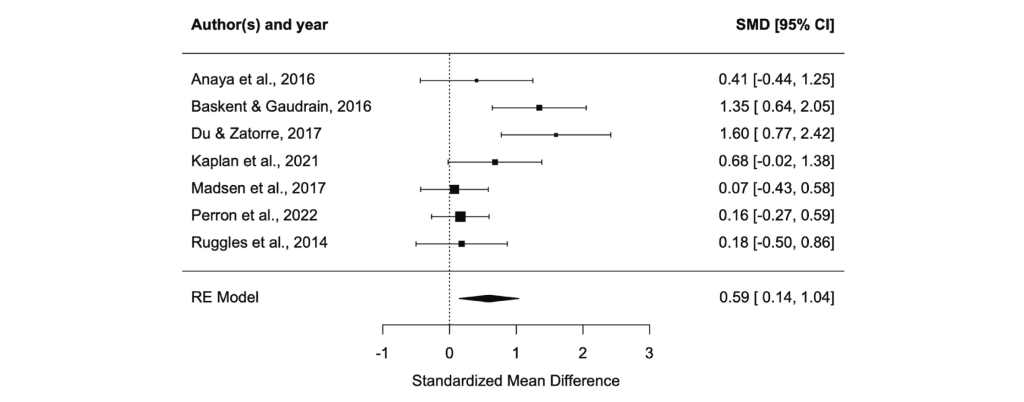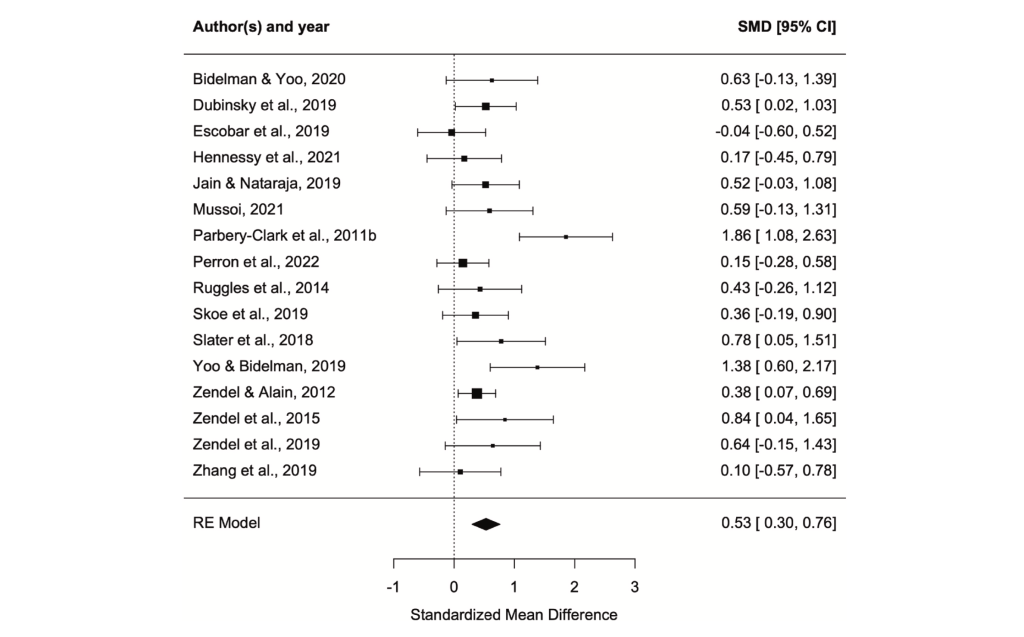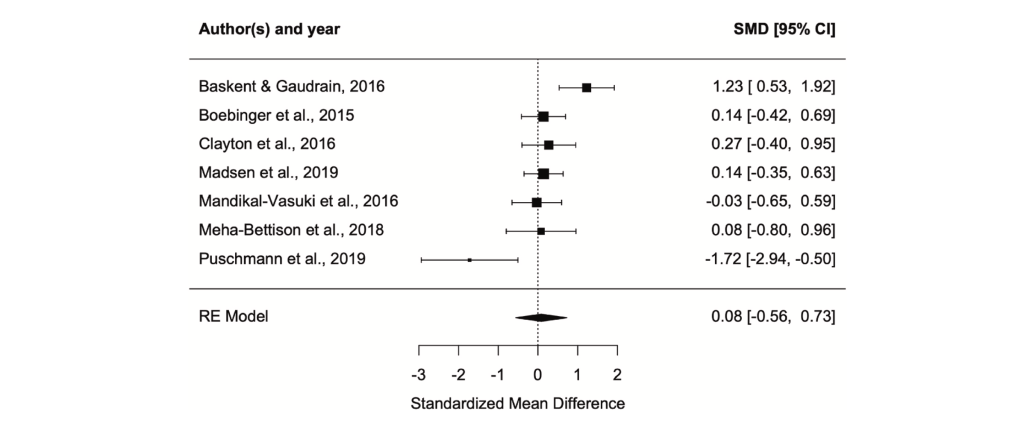Our laboratory has just published a systematic review of the literature and meta-analysis related to this question in the journal Current Research in Neurobiology. This study was part of Elisabeth’s master’s project and was carried out under the supervision and with the help of Pascale, director of the lab. Marilyne, research associate at the lab, and Micah M. Murray, professor at the University of Lausanne in Switzerland, also collaborated on the project, which required a lot of time and energy from the team!
The ability to perceive speech in noisy contexts, such as when many people are talking (e.g., in a noisy restaurant) or home appliance noise (e.g., lawn maintenance equipment, hair dryers) declines with age. Certain musical activities such as singing in a choir or playing a musical instrument could prevent, delay or decrease the decline in speech perception, due to their impact on several brain systems, including the auditory system. However, studies on the relationship between the practice of musical activities and the ability to perceive speech in noise have not all led to the same conclusions. The objective of this study was therefore to provide an objective appraisal of the scientific evidence on the subject. We also sought to understand whether musicians perform better than non-musicians in certain contexts or in general. For example, is a benefit for musicians observable only in difficult listening conditions, such as when the background noise is loud? Or when it is made up of several human voices, which generates a lot of interference with the target speech signal?

To answer these questions, our team searched two databases (Pubmed and PsycNet). This search identified 49 studies (representing 5434 participants) that compared the performance of musicians and non-musicians on tests of speech perception in noise. During these tests, the participants could, for example, be asked to repeat words or sentences pronounced by a speaker in the presence of background noise (e.g., the voices of other people). The methodological quality of each study was independently analyzed by two members of the team. The data and results from each study were extracted independently by two team members. The results were then pooled into quantitative meta-analyses.
The qualitative and quantitative analyses revealed a musician’s advantage which was stronger in difficult listening conditions, such as when the background noise was as loud or louder than the target voice or when the background noise was made up of several talkers. Figure 1 shows the results of studies comparing the performance of musicians and non-musicians when the background noise was louder than the target speech (signal-to-noise ratio <0 decibels). The result of each study is illustrated with a black box. The size of the square reflects the weight assigned to each of the studies in the statistical analysis, which depends on the number of people included in each study (more people => larger box). The bar around each box represents the confidence interval (i.e., the range within which the true value of the effect is likely to be present with a 95% confidence level). If the effect size is very close to 0 (shown as a dotted line), this suggests no advantage. Studies to the right of the dotted line reported a musicians’ advantage. The estimated mean effect for these combined studies (illustrated by the diamond) is 0.59, which corresponds to a significant positive effect of moderate size. The true effect lies between 0.14 and 1.04, as indicated by the confidence interval. As this interval does not contain the value 0, the effect is considered significant, that is, probable.

Figure 1. Effect sizes when the signal-to-noise ratio is less than 0 decibels, i.e., when the background noise is louder than the target speech.
Figure 2 illustrates the results for the studies that compared the performance of musicians and non-musicians on a speech perception test when the background noise included 4 talkers. This difficult listening condition (because it creates a lot of interference) was associated with a moderately significant musicians’ advantage, as indicated by the combined effect size of the studies (0.53) and the confidence interval ranging from 0.30 to 0.76. Thus, musicians were better at perceiving a target voice against a background of multiple talkers, akin to a conversation occurring in a crowded restaurant. This interpretation will need to be further examined, because it is unknown, at this time, whether lab tests generalize to real-life situations, which are far more complex.

Figure 2. Effect sizes when the background noise consists of 4 talkers.
Next, we ran a series of analysis that focused on the perception of speech when the background noise is less loud than the target speech or when the background noise is composed of a single talker; these conditions represent easy listening situations. The results are shown in Figures 3 and 4, where the effect sizes are 0.08 and 0.28 respectively, and for which the confidence interval includes the value 0). These meta-analyses did not reveal a musicians’ advantage. Thus, under unchallenging conditions, the ability to perceive speech is similar among musicians and non-musicians.

Figure 3. Effect sizes when the background noise is a single talker.

Figure 4. Effect sizes when the signal-to-noise ratio is greater than 0 decibels, i.e., when the background noise is lower than the target speech.
In each meta-analysis, we included the age of participants as a moderating variable, to investigate whether the difference in performance between musicians and non-musicians varied with age. The results indicated that age had no significant moderating effect. However, this result should be considered with caution, since only 7 of the 49 studies in this systematic review were carried out with people over the age of 60. More studies are therefore needed to investigate the potential for musical activities to prevent or reduce speech perception decline in older adults.
In short, our results suggest a better ability to perceive speech in noise in musicians compared to non-musicians in challenging listening conditions. This could be related to the fact that people who sing in a choir or who play a musical instrument in an ensemble must be able to focus their attention on a specific auditory cue (e.g., the sound of their own voice or musical instrument) among a multitude of auditory signals to which they are exposed simultaneously. However, the nature of the mechanisms of action involved is still unknown. We have several ongoing projects aimed at understanding the brain mechanisms underlying this positive effect! Stay tuned.
To read the scientific article with all the results:
https://www.sciencedirect.com/science/article/pii/S2665945X23000116


